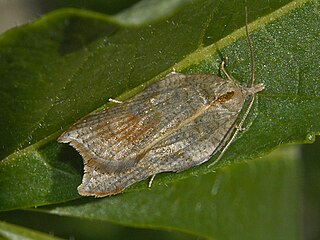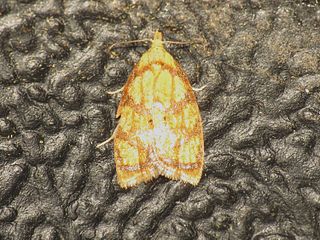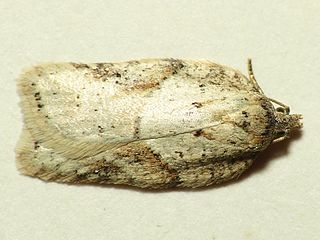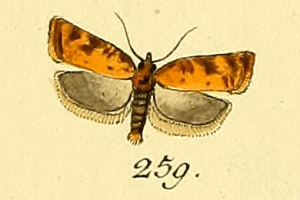
Acleris forsskaleana, the maple leaftier moth, is a moth of the family Tortricidae. It is found in Europe and North America in woodlands and gardens.

Acleris comariana, the strawberry tortrix, is a moth of the family Tortricidae. It is found in Europe, the Caucasus, Amur, Kamchatka, China, Korea and Japan.

Acleris semipurpurana is a species in the moth family Tortricidae, and one of several species of moth commonly known as oak leaftier or oak leaf tier. The larvae feed on the leaves of oak trees in the Eastern United States and southeastern Canada which can be a major cause of defoliation. The loss of leaves can kill or damage the affected trees, which are chiefly in the Lobatae or red oak section of Quercus, or oaks.

Acleris emargana, the notched-winged tortricid, is a moth of the family Tortricidae. The species was first described by Johan Christian Fabricius in 1775.

Acleris is a genus of moths belonging to the subfamily Tortricinae of the family Tortricidae. As of 2007, about 241 species were known.

Acleris hastiana is a moth of the family Tortricidae. It is found in Europe, northern Iran, Kazakhstan, Ala Tau, central Siberia, Irkutsk, the Amur region and China. In North America it is found from the north-eastern United States across southern Canada to British Columbia and south along the Pacific Coast to California.
Acleris tungurahuae is a species of moth belonging to the family Tortricidae. It is found in Ecuador.

Acleris ferrugana is a species of moth of the family Tortricidae. It is found in China, most of Europe and has also been recorded from North America.

Acleris bergmanniana, the yellow rose button moth, is a moth of the family Tortricidae. It is found from most of Europe to the eastern Palearctic realm.

Acleris schalleriana, the viburnum button or Schaller's acleris moth, is a moth of the family Tortricidae. It was described by Carl Linnaeus in 1761. It is found in most of Europe. It is also found in North America. Acleris viburnana is a possible synonym that refers to the North American populations.

Acleris logiana, the black-headed birch leaffolder moth or grey birch button, is a moth of the family Tortricidae. It was described by Carl Alexander Clerck in 1759. It is found in most of Europe, except Ireland, Portugal, most of the Balkan Peninsula and Ukraine. It is also found in North America, the Russian Far East, Korea and Japan.
Acleris nigriradix is a species of moth of the family Tortricidae. It is found in China, Korea, Japan and the Russian Far East.

Acleris quercinana is a species of moth of the family Tortricidae. It was described by Zeller in 1849. It is found in most of Europe, Asia Minor and Iran.
Acleris caucasica is a species of moth of the family Tortricidae. It is found in the Alps of Europe, the eastern Baltic region, the northern parts of European Russia, Georgia, Primorsk and Amur Territory, northern China and Iran.

Acleris lorquiniana, the marsh button, is a species of moth of the family Tortricidae. It is found in Iran and central and northern Europe, where it has been recorded from Great Britain, France, Belgium, the Netherlands, Germany, Denmark, Austria, Switzerland, the Czech Republic, Slovakia, Poland, Romania, Hungary, Sweden, Finland, the Baltic region and Russia. The habitat consists of damp fenland.

Acleris aspersana, the ginger button, is a species of moth of the family Tortricidae. It is found in Europe, where it has been recorded from Ireland, Great Britain, France, the Benelux, Germany, Denmark, Austria, Switzerland, Italy, the Czech Republic, Slovakia, Slovenia, Croatia, Hungary, Bulgaria, Romania, Poland, Norway, Sweden, Finland, the Baltic region and Russia. It is also found in the Near East and the eastern Palearctic realm. Their habitat consists of meadows and forest edges.
Acleris leechi is a species of moth of the family Tortricidae. It is found in Korea, China, Japan and Russia.

Acleris robinsoniana, Robinson's acleris moth, is a species of moth of the family Tortricidae. It is found in North America, where it has been recorded from the north-eastern United States across southern Canada to British Columbia and south to California.
Acleris minuta, the yellow-headed fireworm or lesser apple leaf-folder, is a species of moth of the family Tortricidae. It is found in eastern North America.
Acleris caerulescens is a species of moth of the family Tortricidae. It is found in the Russian Far East (Ussuri), eastern China and Japan.















